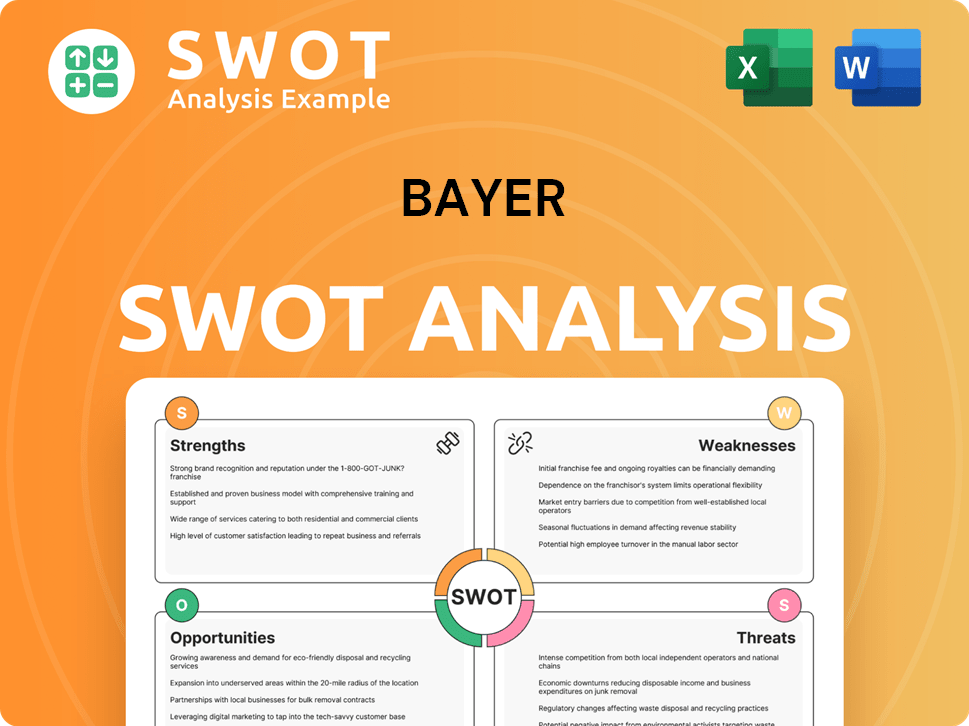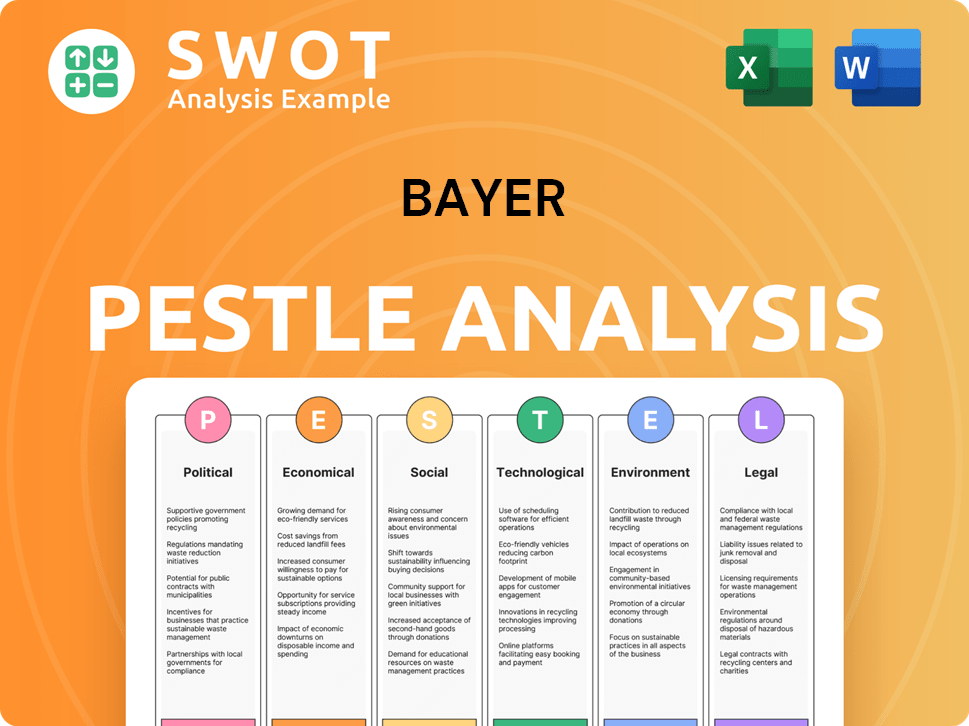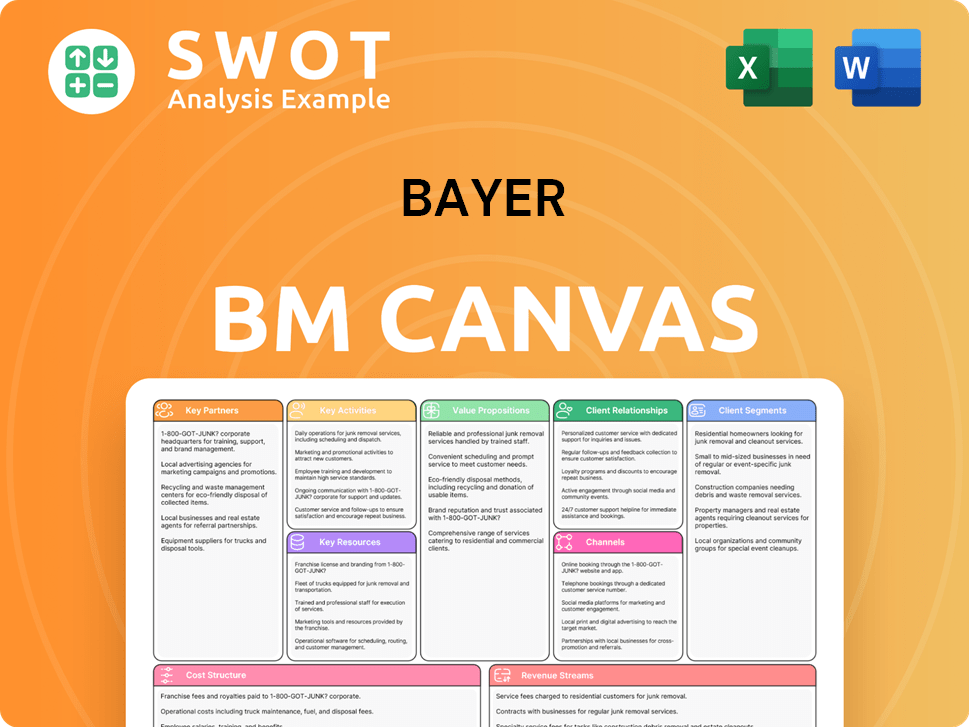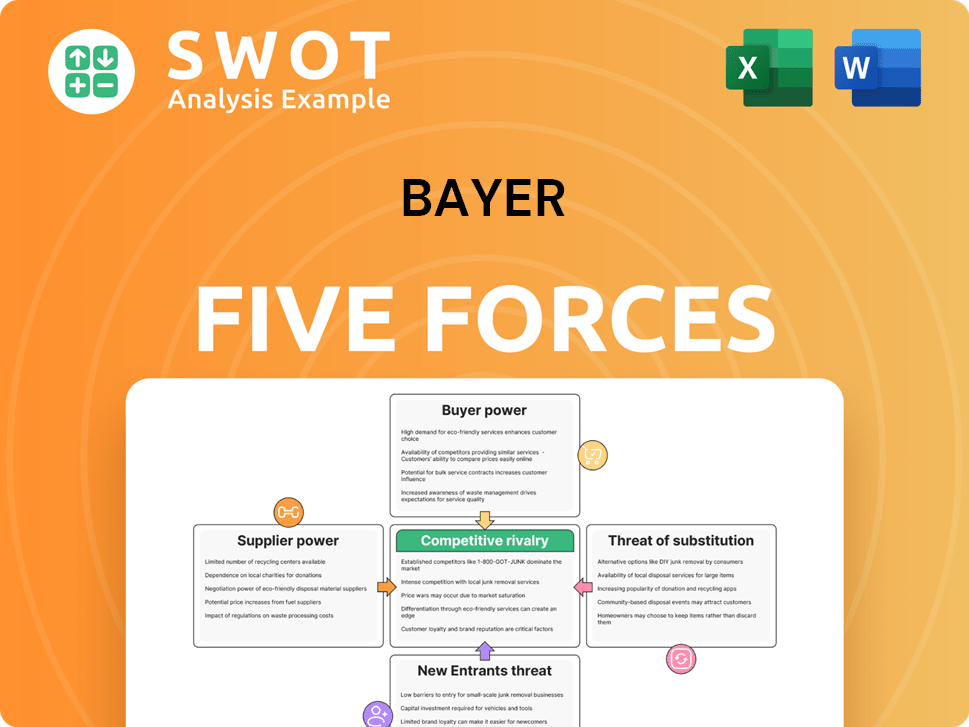Bayer Bundle
Who Really Owns Bayer AG?
Delving into the ownership of Bayer AG, a titan in pharmaceuticals and agriculture, unveils a complex web that influences everything from its strategic decisions to its societal impact. Understanding the Bayer SWOT Analysis and the company's ownership structure is crucial for anyone seeking to understand its trajectory. This exploration goes beyond a simple list of Bayer shareholders, offering insights into the forces shaping this global powerhouse.

From its origins in 1863 to its current global standing, the evolution of Bayer company ownership reflects its adaptability and influence in the market. Examining the Bayer shareholders, including major institutional investors and individual stakeholders, provides a comprehensive view of the company's governance and future direction. This analysis will explore the nuances of who owns Bayer, including the impact of its subsidiaries, acquisitions, and the historical shifts in its ownership structure, offering a deeper understanding of its market capitalization and overall strategy.
Who Founded Bayer?
The foundation of the Bayer company ownership began on August 1, 1863, when Friedrich Bayer and Johann Friedrich Weskott established 'Friedr. Bayer & Co.' in Barmen, Germany. This marked the genesis of a company that would become a global leader in the chemical and pharmaceutical industries. The initial focus was on producing and selling synthetic dyestuffs, a reflection of the founders' expertise and the technological advancements of the time.
The early ownership structure of Bayer AG was rooted in a private partnership model. Details regarding specific equity splits or initial shareholding percentages are not readily available in public records from that era. However, it is understood that the company started as a partnership between Friedrich Bayer, a successful businessman, and Johann Friedrich Weskott, a master dyer. Their combined skills were crucial for the company's early success.
The absence of detailed records about early backers, angel investors, or significant external shareholders suggests a self-funded or closely-held structure. The founders' direct control allowed them to shape the company's direction without substantial external influence. This approach was typical of industrial ventures during the mid-19th century, emphasizing the founders' vision for innovation and quality. To understand more about the company's strategy, you can read about the Marketing Strategy of Bayer.
The early ownership of Bayer, now a major player in the pharmaceutical industry, was characterized by a private partnership between Friedrich Bayer and Johann Friedrich Weskott. There is limited information available about early external investors or significant ownership changes during this period. The founders' direct control allowed them to steer the company's early development without significant external influence.
- Founders: Friedrich Bayer and Johann Friedrich Weskott.
- Initial Focus: Production and sale of synthetic dyestuffs.
- Ownership Structure: Private partnership, typical of the mid-19th century.
- External Influence: Limited external investment or influence in the early stages.
Bayer SWOT Analysis
- Complete SWOT Breakdown
- Fully Customizable
- Editable in Excel & Word
- Professional Formatting
- Investor-Ready Format

How Has Bayer’s Ownership Changed Over Time?
The evolution of Bayer company ownership reflects its transition from a private partnership to a publicly traded entity. The initial public offering (IPO) in 1881 marked a pivotal moment, allowing for broader public ownership. While the exact initial market capitalization from 1881 isn't readily available, this move laid the foundation for the institutional investment that characterizes its shareholder base today. This shift was crucial in shaping Bayer's history and its approach to capital and growth.
The acquisition of Monsanto in 2018 significantly impacted Bayer AG. This $63 billion deal, aimed at bolstering the Crop Science division, increased debt and affected investor sentiment. The company has faced legal challenges and financial pressures, leading to calls from activist investors for structural changes, including potential breakups of its divisions. As of the first quarter of 2025, the company is navigating these pressures while focusing on de-risking legal liabilities and improving financial performance.
| Key Event | Year | Impact on Ownership |
|---|---|---|
| Initial Public Offering (IPO) | 1881 | Transitioned from private to public ownership, enabling broader public investment. |
| Acquisition of Monsanto | 2018 | Increased debt, impacted share price, and led to legal challenges and investor scrutiny. |
| Activist Investor Pressure | Early 2023-2025 | Calls for structural changes, including potential breakups of divisions, to unlock shareholder value. |
Currently, Bayer shareholders are primarily large institutional investors. As of late 2024 and early 2025, major stakeholders include asset managers and mutual funds. Vanguard Group Inc. and BlackRock Inc. are consistently among the largest shareholders, holding significant percentages through various funds. While specific percentages fluctuate, these firms typically hold several percentage points of Bayer stock ownership breakdown. Other significant investors often include Norges Bank Investment Management and Capital Research Global Investors. This wide dispersal reflects Bayer's status as a leading global corporation. For more details on the company's financial performance, you can explore resources like the company's investor relations section or financial news outlets to find Bayer company financial information.
The ownership structure of Bayer AG is dominated by institutional investors, reflecting its global presence. Major stakeholders include firms like Vanguard and BlackRock, holding significant shares. This structure influences strategic decisions and governance.
- Institutional investors hold a significant portion of shares.
- Activist investors influence strategic direction.
- The acquisition of Monsanto was a major event.
- Who owns Bayer has evolved over time.
Bayer PESTLE Analysis
- Covers All 6 PESTLE Categories
- No Research Needed – Save Hours of Work
- Built by Experts, Trusted by Consultants
- Instant Download, Ready to Use
- 100% Editable, Fully Customizable

Who Sits on Bayer’s Board?
The Board of Directors of Bayer AG is pivotal in steering the company's direction and representing its shareholders. As of early 2025, the board includes a mix of independent members, representatives from major shareholders, and executive management. For instance, Norbert Winkeljohann holds the position of Chairman of the Supervisory Board, an independent role. Other board members bring expertise in areas such as finance, science, and international business, ensuring a diverse range of perspectives. While specific board members directly representing major institutional shareholders are not always appointed, the interests of these investors are considered through ongoing dialogue and the board's fiduciary duties. Understanding the dynamics of Bayer's growth strategy is crucial for grasping how these board decisions shape the company's future.
The board's composition reflects a commitment to comprehensive oversight and strategic guidance. The presence of independent directors helps ensure impartial decision-making, while the inclusion of members with varied backgrounds supports a well-rounded approach to complex issues. This structure is designed to promote transparency and accountability, which are essential for maintaining investor confidence and driving long-term value. The board's role is especially critical given the company's size and the scope of its global operations, making effective governance a key factor in its continued success.
| Board Member | Role | Expertise |
|---|---|---|
| Norbert Winkeljohann | Chairman of the Supervisory Board | Finance |
| (Various) | Members | Science, International Business |
| (Various) | Members | Executive Management |
Bayer operates under a one-share-one-vote system, which means each ordinary share has one voting right. This structure helps to distribute voting power more equitably among shareholders. There are no publicly known golden shares or founder shares that grant disproportionate voting power to specific individuals or entities. This approach ensures that all shareholders have a proportional say in the company's decisions, promoting fairness and transparency in corporate governance. This is a key aspect of understanding who owns Bayer and how decisions are made within the company.
Bayer's voting structure is based on one share, one vote, ensuring equitable power distribution. This structure prevents any single entity from having excessive control through special voting rights. Understanding the voting dynamics is crucial for shareholders and investors.
- One share, one vote principle.
- No special voting rights.
- Promotes equitable shareholder influence.
- Enhances transparency in governance.
Bayer Business Model Canvas
- Complete 9-Block Business Model Canvas
- Effortlessly Communicate Your Business Strategy
- Investor-Ready BMC Format
- 100% Editable and Customizable
- Clear and Structured Layout

What Recent Changes Have Shaped Bayer’s Ownership Landscape?
Over the past few years, the ownership structure of Bayer AG, often referred to as Bayer's company ownership, has been significantly influenced by several factors. These include the integration of Monsanto following its acquisition, ongoing legal challenges, and increasing involvement from activist investors. While there haven't been major changes like large-scale secondary offerings or significant founder departures recently, the investor base has been affected by share price volatility and strategic reviews.
Activist investors have played a more prominent role. For instance, Trian Fund Management, led by Nelson Peltz, and Bluebell Capital Partners have taken stakes in Bayer, advocating for strategic shifts. This activism often prompts institutional investors to re-evaluate their positions, potentially causing shifts in major shareholdings. Industry-wide trends, such as increased institutional ownership, continue to be relevant. However, the specific challenges faced by Bayer, particularly the Roundup litigation and its financial implications, have likely influenced the mix of institutional investors.
| Metric | Value (as of Early 2024) | Source |
|---|---|---|
| Market Capitalization | Approximately $30 billion | Financial News Sources |
| Institutional Ownership | Around 60-70% | Financial Data Providers |
| Activist Investor Stakes | Varies, but significant influence | Public Filings and News Reports |
Bayer's management has focused on de-risking the company, especially regarding the Roundup litigation, and improving operational performance. As of early 2025, no definitive plans for privatization or dramatic structural changes, like a complete breakup, have been announced. However, ongoing discussions about potential future ownership changes, driven by internal strategic reviews and external activist pressure, indicate a dynamic period for Bayer's ownership landscape. Capital allocation strategies, including potential share buybacks or divestitures, will continue to influence its ownership profile in the coming years. The company's market capitalization as of early 2024 was approximately $30 billion, with institutional ownership hovering around 60-70%.
The major shareholders of Bayer include a mix of institutional investors, such as large asset managers and potentially value-oriented funds. The specific composition of the shareholder base is dynamic, influenced by the company's performance and strategic initiatives.
Bayer operates through various subsidiaries, encompassing pharmaceuticals, consumer health, and crop science. These subsidiaries contribute to the overall value and strategic direction of the company, with their performance impacting investor sentiment and ownership decisions.
Analyzing Bayer's financial information, including revenue, profitability, and debt levels, provides insights into its financial health. This information is crucial for understanding the company's ability to manage its liabilities and implement strategic initiatives.
The largest shareholders in Bayer are primarily institutional investors, including asset management firms and investment funds. These entities hold substantial stakes and can significantly influence corporate strategy and decision-making through their voting power.
Bayer Porter's Five Forces Analysis
- Covers All 5 Competitive Forces in Detail
- Structured for Consultants, Students, and Founders
- 100% Editable in Microsoft Word & Excel
- Instant Digital Download – Use Immediately
- Compatible with Mac & PC – Fully Unlocked

Related Blogs
- What are Mission Vision & Core Values of Bayer Company?
- What is Competitive Landscape of Bayer Company?
- What is Growth Strategy and Future Prospects of Bayer Company?
- How Does Bayer Company Work?
- What is Sales and Marketing Strategy of Bayer Company?
- What is Brief History of Bayer Company?
- What is Customer Demographics and Target Market of Bayer Company?
Disclaimer
All information, articles, and product details provided on this website are for general informational and educational purposes only. We do not claim any ownership over, nor do we intend to infringe upon, any trademarks, copyrights, logos, brand names, or other intellectual property mentioned or depicted on this site. Such intellectual property remains the property of its respective owners, and any references here are made solely for identification or informational purposes, without implying any affiliation, endorsement, or partnership.
We make no representations or warranties, express or implied, regarding the accuracy, completeness, or suitability of any content or products presented. Nothing on this website should be construed as legal, tax, investment, financial, medical, or other professional advice. In addition, no part of this site—including articles or product references—constitutes a solicitation, recommendation, endorsement, advertisement, or offer to buy or sell any securities, franchises, or other financial instruments, particularly in jurisdictions where such activity would be unlawful.
All content is of a general nature and may not address the specific circumstances of any individual or entity. It is not a substitute for professional advice or services. Any actions you take based on the information provided here are strictly at your own risk. You accept full responsibility for any decisions or outcomes arising from your use of this website and agree to release us from any liability in connection with your use of, or reliance upon, the content or products found herein.